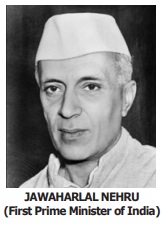Duties and functions, Council, Categories - Prime Minister of India | 10th Social Science : Civics : Chapter 2 : Central Government of India
Chapter: 10th Social Science : Civics : Chapter 2 : Central Government of India
Prime Minister of India
Prime Minister
Article
74 (1) says: There shall be a council of ministers with the Prime Minster as
the head to aid and advice the President.
The post of Prime Minister of India has adopted the Westminster (England) model of constitutional democracy. The parliment of England is situated in Westminister so it's called Westminister parliament.

The
leader of the majority party in Lok Sabha is appointed by the President as the
Prime Minister. The other ministers are appointed by the President on the
advice of the Prime Minister. If no party commands absolute majority in the Lok
Sabha, the President can summon the leader of any party who, in his opinion,
can manage to form a ministry. The President administers to the ministers the
oath of office and of secrecy. A person who is not a member of the Parliament
can be appointed as a minister but he has to get himself elected to the
Parliament within six months. Ministers are individually as well as
collectively responsible to the Lok Sabha.
Duties and functions of Prime Minister
Article
78 mentioned the duties of the Prime Minister:
• The
Prime Minister decides the rank of his ministers and distributes various
departments.
• The
Prime Minister decides the dates and the agenda of the meeting of the Cabinet
which he presides.
• The
Prime Minister informally consults two or three of his senior colleagues when
he does not convene a Cabinet meeting.
• The
Prime Minister supervises the work of various ministers.
• To
converse to the President all decisions of the Council of Ministers connecting
to the government of the affairs of the Union and proposals for legislation.
• The
Prime Minister act as the link between the President and the Council of
Ministers.
• The
Prime Minister is the leader of the nation and chief spokesperson of the
country.
• As the
leader of the nation, the Prime Minister represents our nation at all
international conferences like the commonwealth, summit of the non aligned
nations and SAARC nations.
Council of Ministers
After the
elections, the President of India, on the advice of the Prime Minister,
appoints the council of ministers. The Constitution of India restricts the
number of the Council of Ministers including the Prime Minister to 15% of the
total members of the Lok Sabha.
Categories of the Ministers
The
ministers are classified under three ranks
(i) Cabinet Ministers
(ii) Ministers of State
(iii) Deputy Ministers.
Cabinet Ministers
The
Cabinet is an informal body of senior ministers who form the nucleus of
administration. Important decisions of the government are taken by the Cabinet,
such as defense, finance, external affairs and home.
Ministers of State
These
ministers belong to the second category of ministers in the council. They are
also in charge of ministries or departments but they do not participate in the
meetings of the cabinet unless invited to do so.
Deputy Ministers
They are
the lowest ranked ministers in the cabinet. They assist either the Ministers of
Cabinet or State in the performance of the duties entrusted to them.
Related Topics